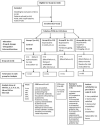Effect of caudal bupivacaine alone and with adjuvant fentanyl and nalbuphine to minimize the catheter-related bladder discomfort after tubeless percutaneous nephrolithotomy: A prospective randomized study
- PMID: 33840935
- PMCID: PMC8022066
- DOI: 10.4103/joacp.JOACP_285_18
Effect of caudal bupivacaine alone and with adjuvant fentanyl and nalbuphine to minimize the catheter-related bladder discomfort after tubeless percutaneous nephrolithotomy: A prospective randomized study
Abstract
Background and aims: Catheter-related bladder discomfort (CRBD) is a major cause of postoperative morbidity following urological procedures. The aim of this study was to compare the effect of caudal bupivacaine alone and with adjuvant fentanyl and nalbuphine to minimize the severity of CRBD after tubeless percutaneous nephrolithotomy (PCNL).
Material and methods: A randomized prospective study was conducted on one hundred thirty-two (American society of Anaesthesiologist physical status I to II) patients who presented for tubeless PCNL under general anesthesia. Patients were randomly divided into four groups control (C), bupivacaine (B), bupivacaine-fentanyl (BF), and bupivacaine-nalbuphine (BN) by using computer-generated codes. All patients received local infiltration at the procedure site while Groups B, BF, and BN received caudal epidural block (CEB) under ultrasound guidance after conclusion of the procedure. Groups B, BF, and BN received bupivacaine alone, bupivacaine-fentanyl, and bupivacaine-nalbuphine, respectively, for CEB. Patients were monitored 24 h for CRBD scale, visual analogue score (VAS), and duration of analgesia at 30 min, 1, 2, 4, 6, 12, 18, and 24 h intervals. The analgesics were supplemented if the CRBD score was >2 and VAS was ≥4. Student t-test, analysis of variance, and Chi-square test were applied for quantitative, within group occurrence, and qualitative analysis respectively.
Results: The CRBD scores were considerably lower in the Groups BF and BN as compared to Groups C and B during the first four hours. The duration of analgesia was significantly prolonged in Group BN (475 ± 47 min) versus BF (320 ± 68 min) versus B (104 ± 40 min) versus C (26 ± 14 min).
Conclusions: The severity of CRBD can be reduced with CEB. The effect of CEB can be prolonged with the addition of opioid.
Keywords: Bupivacaine; catheter-related bladder discomfort; caudal epidural block; fentanyl; nalbuphine.
Copyright: © 2021 Journal of Anaesthesiology Clinical Pharmacology.
Conflict of interest statement
There are no conflicts of interest.
Figures




Similar articles
-
"Comparison of Nalbuphine Hydrochloride and Fentanyl as an Adjuvant to Bupivacaine for Spinal Anesthesia in Lower Abdominal Surgeries:" A Randomized, Double-blind Study.Anesth Essays Res. 2017 Oct-Dec;11(4):859-863. doi: 10.4103/aer.AER_40_17. Anesth Essays Res. 2017. PMID: 29284839 Free PMC article.
-
A Comparative Study of Intrathecal Fentanyl and Nalbuphine as an Adjuvant to Hyperbaric Bupivacaine for Spinal Anesthesia in Lower Limb Orthopedic Surgeries: A Prospective, Double-Blind, Randomized Controlled Study.Cureus. 2023 Jun 30;15(6):e41230. doi: 10.7759/cureus.41230. eCollection 2023 Jun. Cureus. 2023. PMID: 37529511 Free PMC article.
-
Postoperative Analgesia with Intrathecal Nalbuphine versus Intrathecal Fentanyl in Cesarean Section: A Double-Blind Randomized Comparative Study.Anesth Essays Res. 2018 Apr-Jun;12(2):561-565. doi: 10.4103/aer.AER_41_18. Anesth Essays Res. 2018. PMID: 29962635 Free PMC article.
-
The efficacy of peripheral nerve block on postoperative catheter-related bladder discomfort in males: A systematic review and meta-analysis.Front Surg. 2023 Feb 3;10:1099628. doi: 10.3389/fsurg.2023.1099628. eCollection 2023. Front Surg. 2023. PMID: 36816007 Free PMC article. Review.
-
Predictors of Catheter-Related Bladder Discomfort After Surgery: A Literature Review.J Clin Med Res. 2023 Apr;15(4):208-215. doi: 10.14740/jocmr4873. Epub 2023 Apr 28. J Clin Med Res. 2023. PMID: 37187710 Free PMC article. Review.
Cited by
-
Intravesical bupivacaine in reducing catheter-related bladder discomfort and lower urinary tract symptoms after transurethral surgery: A randomized controlled trial.Indian J Urol. 2024 Jul-Sep;40(3):161-166. doi: 10.4103/iju.iju_431_23. Epub 2024 Jul 1. Indian J Urol. 2024. PMID: 39100603 Free PMC article.
-
Dose-Response Analysis of Nalbuphine for Alleviating Catheter-Related Bladder Discomfort After Ureteroscopic Lithotripsy in Men: A Retrospective Study.Drug Des Devel Ther. 2025 Jun 19;19:5283-5292. doi: 10.2147/DDDT.S511613. eCollection 2025. Drug Des Devel Ther. 2025. PMID: 40552093 Free PMC article.
-
The Effect of Intravesical Diluted Bupivacaine on Catheter-Related Bladder Discomfort in Young and Middle-Aged Male Patients During Postanaesthetic Recovery.Turk J Anaesthesiol Reanim. 2020 Dec;48(6):454-459. doi: 10.5152/TJAR.2020.18999. Epub 2020 Feb 17. Turk J Anaesthesiol Reanim. 2020. PMID: 33313583 Free PMC article.
-
Effect of Pudendal Nerve Block on the Prevention of Postoperative Bladder Spasm and Catheter-Related Bladder Discomfort in Male Patients Undergoing Transurethral Holmium Laser Enucleation of the Prostate.Clin Interv Aging. 2022 Nov 30;17:1729-1738. doi: 10.2147/CIA.S384612. eCollection 2022. Clin Interv Aging. 2022. PMID: 36474581 Free PMC article. Clinical Trial.
References
-
- Binhas M, Motamed C, Hawajri N, Yiou R, Marty J. Predictors of catheter-related bladder discomfort in the post-anaesthesia care unit. Ann Fr Anesth Reanim. 2011;30:122–5. - PubMed
-
- Agarwal A, Yadav G, Gupta D, Singh PK, Singh U. Evaluation of intra-operative tramadol for prevention of catheter-related bladder discomfort: A prospective, randomized, double-blind study. Br J Anaesth. 2008;101:506–10. - PubMed
-
- Zhang Z, Cao Z, Xu C, Wang H, Zhang C, Pan A, et al. Solifenacin is able to improve the irritative symptoms after transurethral resection of bladder tumors. Urology. 2014;84:117–21. - PubMed
LinkOut - more resources
Full Text Sources
Miscellaneous
